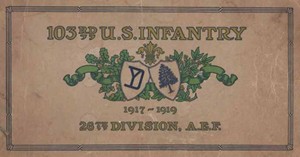
of the 26th Division of the U.S. Army
during World War I
 | The History of the 103rd Regiment of the 26th Division of the U.S. Army during World War I |
| Table of Contents | ||
| attack which was to be made the eighth or ninth. A battalion ot the 104th was detached from the division for the same purpose. This move into :1 new divi- sion area was a difficult one; roads were in bad condition, there was the constant menace of shell Hre, and there had been no chance to make a proper reconnais- sance; in fact, none had been made. Such eonditions along with the fact that our old Colonel had been relieved on the seventh as also thc Major of the 3rd Battalion presented a rather uncertain situation, On the night ol` the eighth the 3rd Battalion moved up to be set for the at- tack of the ninth; meanwhile our lst Battalion had pushed into the enemy’s old front line on the eighth; the enemy was withdrawing. The 2nd Battalion took over our old front so that the two battalions were set to follow up on the ninth. After midnight November 8, the 3rd Battalion, which had gone into position with the 79th, received orders to report back to the 103rd to join them in the attack which was to start at six olclock. By cutting across another regimental sector, that of the 104th, this movement was accomplished on time. The following report of Lieutenant Colonel Dowell is incorporated: Hmu_m1i·mxs, 103rd U.S. Iximwmy, 19 Nov., 1918. Franz: Commanding ()FHc0r, 103rd U.S. Infxmbry, T0: Commanding General, 26th Division (Attoiition G—3). Through Commanding General, 52nd Inf, Brigade. Subjecw Report of Operations from November Sth to 11th, 1918. MAPS: `Verdun B , Em!] A }1/.20.000 | ||
| Original Version of Page |